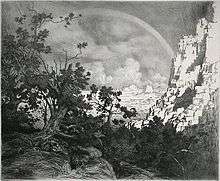George Elbert Burr
| George Elbert Burr | |
|---|---|
 Edge of the Desert, Arizona. Etching by George Elbert Burr | |
| Born |
1859 Munroe Falls, Ohio |
| Died | 1939 |
| Nationality | American |
| Education | Art Institute of Chicago |
| Known for | Printmaking |
George Elbert Burr (1859–1939) was an American printmaker and painter best known for his etchings and drypoints of the desert and mountain regions of the American West.
Life
Burr was born in 1859 in Munroe Falls, Ohio. He studied at the Art Institute of Chicago for one winter, his only formal artistic training. Nevertheless, he enjoyed early success as a commercial artist, providing illustrations for Harper's, Scribner's Magazine, Frank Leslie's Weekly, and The Cosmopolitan. In 1892, he began a four-year project illustrating a catalog of Heber R. Bishop's collection of jade antiquities for the New York Metropolitan Museum of Art. This project, which involved producing etchings of over a thousand artifacts, paid well enough for Burr to embark on an extended tour of Europe with his wife upon its completion. Over the next five years, as they traveled in Italy, Germany, and the British Isles, Burr amassed sketches and watercolors that would provide the source material for his copperplate etchings of European scenes.
A few years after his return to the United States, an attack of the flu prompted Burr to move to Denver for the benefit of his health. It was there, during summers spent in a cabin studio in a steep wooded canyon with panoramic views of the Rocky Mountains, that Burr began to concentrate on the work that made him famous. In 1910, he built a brick house and studio at 1325 Logan Street in Denver. The building was purchased in 1924 by the Denver Woman's Press Club, which continues to own and operate it as a clubhouse. In 1924 the artist settled in Phoenix, Arizona, where he would remain for the rest of his life. This change of scenery gave him the opportunity to round out his oevure of Western landscapes with expansive views of the Sonoran and Mojave deserts.
Today George Elbert Burr is widely considered to be one of the finest of the early 20th-century American etchers. His prints are in a number of prominent collections including the Smithsonian American Art Museum,[1] the British Museum, the French National Print Collection, Luxembourg Gallery, Victoria and Albert Museum, the New York Public Library, Brooklyn Museum,[2] Museum of Northern Arizona.[3] and the Congressional Library in Washington, D.C.
References
- ↑ "George Elbert Burr". Smithsonian American Art Museum. Retrieved 2018-08-02.
- ↑ "Brooklyn Museum". www.brooklynmuseum.org. Retrieved 2018-08-02.
- ↑ "ETCHINGS BY AMERICAN ARTIST GEORGE ELBERT BURR AT MNA - Museum of Northern Arizona". Museum of Northern Arizona. 2006-03-17. Retrieved 2018-08-02.
Sources
- Seeber, Louise Combes (1971). George Elbert Burr, 1859-1939; catalogue raisonné and guide to the etched works with biographical and critical notes. Flagstaff, Ariz: Northland Press. ISBN 0-87358-067-2.